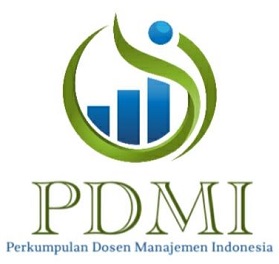The Role of Mediating Islamic Personality and Value Satisfaction on the Effect of Relationship Marketing on Customer Loyalty
DOI:
https://doi.org/10.21580/jdmhi.2020.2.2.6156Keywords:
Relationship marketing, Islamic personality, Value satisfaction, Consumer loyaltyAbstract
The study of consumer loyalty to a product is an essential topic for academics and practice. There is not much empirical research on the effect of marketing on allegiance, based on the literature review; it has produced propositions that determine consumer loyalty in a product that is influenced by marketing effectiveness. This study uses a qualitative approach to using literature studies. Based on a literature review, it produces propositions that determine consumer loyalty in a product that is influenced by marketing effectiveness. Besides, there is a mediating effect of Islamic personality and consumer perceived value satisfaction. This study also links value satisfaction and customer value loyalty. Islamic personality is a mediating variable. This study also discusses the combination of perceived value and consumer satisfaction into value satisfaction.
Downloads
References
Alrubaiee, L., & Al-Nazer, N. (2010). Investigate the Impact of Relationship Marketing Orientation on Customer Loyalty: The Customer's Perspective. International Journal of Marketing Studies, 2(1), 155–174. https://doi.org/10.5539/ijms.v2n1p155
Amoako, G. K. (2019). Relationship Marketing, Orientation, Brand Equity and Firm Value: The Mediating Role of Customer Value—An Emerging Market Perspective. Journal of Relationship Marketing, 18(4), 280–308. https://doi.org/10.1080/15332667.2019.1639589
Boateng, S. L. (2019). Online relationship marketing and customer loyalty: a signaling theory perspective. International Journal of Bank Marketing, 37(1), 226–240. https://doi.org/10.1108/IJBM-01-2018-0009
Cossío-Silva, F. J., Revilla-Camacho, M. Á., Vega-Vázquez, M., & Palacios-Florencio, B. (2016). Value co-creation and customer loyalty. Journal of Business Research, 69(5), 1621–1625. https://doi.org/10.1016/j.jbusres.2015.10.028
Hunt, S. D., Arnett, D. B., & Madhavaram, S. (2006). The explanatory foundations of relationship marketing theory. Journal of Business and Industrial Marketing, 21(2), 72–87. https://doi.org/10.1108/10610420610651296
Husnain, M., & Akhtar, W. (2015). Relationship Marketing and Customer Loyalty: Evidence from Banking Sector in Pakistan. Type: Double Blind Peer Reviewed International Research Journal Publisher: Global Journals Inc, 15(10).
Iglesias, O., Sauquet, A., & Montaña, J. (2011). The role of corporate culture in relationship marketing. European Journal of Marketing, 45(4), 631–650. https://doi.org/10.1108/03090561111111361
Jos Akkermans, A. H. de L. (2018). 기사 (Article) 와안내문 (Information) [. The Eletronic Library, 34(1), 1–5.
Keshavarz, Y., & Jamshidi, D. (2018). Service quality evaluation and the mediating role of perceived value and customer satisfaction in customer loyalty. International Journal of Tourism Cities, 4(2), 220–244. https://doi.org/10.1108/IJTC-09-2017-0044
Khir, M. M., Othman, A. K., Hamzah, M. I., Demong, N. A. R., Omar, E. N., & Abbas, M. K. M. (2016). Islamic Personality Model: A Conceptual Framework. Procedia Economics and Finance, 37(June), 137–144. https://doi.org/10.1016/s2212-5671(16)30104-6
Luu, N., Ngo, L. V., & Cadeaux, J. (2018). Value synergy and value asymmetry in relationship marketing programs. Industrial Marketing Management, 68, 165–176. https://doi.org/10.1016/j.indmarman.2017.10.011
Nadhifah, H. H., & Adinugraha, H. H. (2020). Analysis of Factors influencing the Purchasing Decision of Facial Foam labeled Halal. Journal of Digital Marketing and Halal Industry, 2(1), 65–80. http://dx.doi.org/10.21580/jdmhi.2020.2.1.5283
Nik Ahmad Hisham, I., & Tekke, M. (2015). Development and initial validation of integrative islamic personality inventory. Advances in Environmental Biology, 9(18), 163–170.
O'Malley, L. (2014). Relational marketing: development, debates and directions. Journal of Marketing Management, 30(11-12), 1220–1238. https://doi.org/10.1080/0267257X.2014.939592
Othman, A. K., Hamzah, M. I., & Hashim, N. (2014). Conceptualizing the Islamic Personality Model. Procedia - Social and Behavioral Sciences, 130, 114–119. https://doi.org/10.1016/j.sbspro.2014.04.014
Othman, N. (2015). A Preface to the Islamic Personality Psychology. International Journal of Psychological Studies, 8(1), 20. https://doi.org/10.5539/ijps.v8n1p20
Saeed, S., & Siddiqui, D. A. (2020). The Impact of Muslim Personality Traits on Sales Performance in Islamic Banks. February 2018.
Sheth, J. N., & Parvatiyar, A. (2015). The Evolution of Relationship Marketing Orientations. 5931(4), 25–37. https://doi.org/10.4018/978-1-4666-8231-3.ch002
Sheth, J., Parvatiyar, A., & Berry, L. L. (2014). Relationship Marketing of Services: Growing Interest, Emerging Perspectives. Handbook of Relationship Marketing, 23(4), 149–170. https://doi.org/10.4135/9781452231310.n6
Styles, C., & Ambler, T. (2003). The coexistence of transaction and relational marketing: Insights from the Chinese business context. Industrial Marketing Management, 32(8), 633–642. https://doi.org/10.1016/j.indmarman.2003.06.004
Thommen, J.-P., Achleitner, A.-K., Gilbert, D. U., Hachmeister, D., Jarchow, S., Kaiser, G., Thommen, J.-P., Achleitner, A.-K., Gilbert, D. U., Hachmeister, D., Jarchow, S., & Kaiser, G. (2020). Marketingmix. Allgemeine Betriebswirtschaftslehre, 145–148. https://doi.org/10.1007/978-3-658-27246-3_10
Yeh, C. H., Wang, Y. S., & Yieh, K. (2016). Predicting smartphone brand loyalty: Consumer value and consumer-brand identification perspectives. International Journal of Information Management, 36(3), 245–257. https://doi.org/10.1016/j.ijinfomgt.2015.11.013
Downloads
Published
Issue
Section
License
The copyright of the received article shall be assigned to the journal as the publisher of the journal. The intended copyright includes the right to publish the article in various forms (including reprints). The journal maintains the publishing rights to the published articles. Authors are allowed to use their articles for any legal purposes deemed necessary without written permission from the journal with an acknowledgment of initial publication to this journal.
The work under license Creative Commons Attribution-ShareAlike 4.0 International License.




.png)
